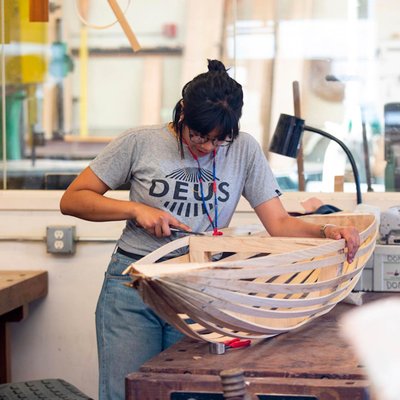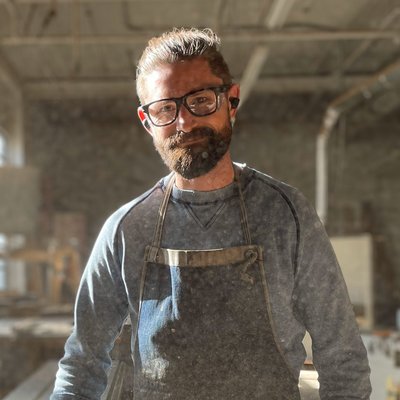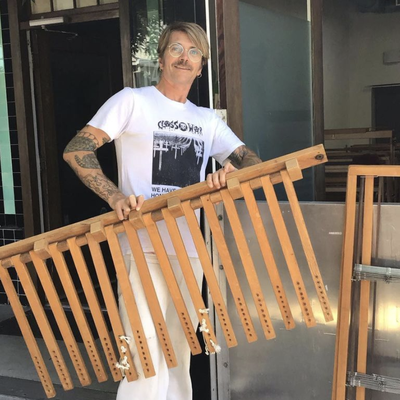Interdisciplinary craft and technology concentrations
BFA Interdisciplinary majors can expand their practice through a material-based concentration in cutting-edge creative technologies or timeless traditional forms
Craft & Creative Technologies
Get hands-on and tech-forward
Love working with your hands but also curious about code? In the Craft & Creative Technologies (CCT) concentration, you’ll combine traditional craft skills with cutting-edge tools and ideas—from laser-cutting textiles or building interactive sculptures to coding wearables or creating AR-enhanced art installations.
CCT lets you explore how making and technology intersect. Today’s artists and designers are systems thinkers and storytellers, and with a CCT concentration, you’ll build projects that are tactile and totally your own while gaining the skills to imagine and prototype the future.
Build the future
Ceramics
Make the provocative and unexpected
Ceramic facilities include access to a 3D clay printer, a computerized gas kiln, a glaze room and slip casting area, a spray booth, and a decal-printing station.
Study clay as both a timeless material and a platform for innovation. CCA has a longstanding reputation as a ceramics powerhouse, with a legacy shaped by influential artists and a spirit of fearless experimentation—from Viola Frey’s pioneering mid-century sculptures to more recent student work building ceramic nests for endangered seabirds.
You’ll learn a full range of techniques, including wheel-throwing, handbuilding, glaze chemistry, and kiln firing. All while pushing the boundaries through scale, installation, and interdisciplinary approaches. Our expansive, purpose-built studios feature dedicated workspaces that support focused practice and bold ideas. You’ll have the space to build a material language that’s all your own.
Transform the studio
Furniture
Reimagine what furniture can be
Explore courses
With deep roots in the Arts & Crafts Movement, CCA champions both fine craftsmanship and conceptual experimentation in furniture design. You’ll work with wood, metal, digital tools, and hybrid materials to design and build objects that are functional, sculptural, or somewhere in between.
You’ll gain the technical skills and critical perspective to create work that’s unexpected and built to last, whether you’re prototyping seating for public space or handcrafting a one-of-a-kind piece. From sketch to final build, your studio practice will empower you to shape ideas about furniture into thoughtful form.
Deepen your practice with a minor in Furniture. This minor focuses on hands-on prototyping, craft techniques, and a strong grounding in form and function, helping you move ideas off the screen and into the studio with confidence and precision. You'll graduate with a deeper understanding of materials and the practical skills that add value to any industrial design role.
Design with intention
Printmedia
Sharpen your message in print
Explore the depth and range of print techniques—from intaglio and letterpress to screenprinting, risograph, and digital tools—while building a strong foundation in both process and creative thinking. Our Printmedia studios are a place to mix traditional printing methods with bold ideas and personal expression.
You might make zines, print creative writing on fabric, build sculptures wheatpasted with posters, or create installations and performances amplified by printed art. No matter what you pursue, you’ll gain skills that translate across disciplines and learn how to use print as a powerful tool for storytelling, activism, and creative impact in today’s image-saturated world.
Make a statement
Sculpture
Make sculpture at any scale
In large-scale workspaces—including outdoor maker yards—and fully equipped fabrication shops, you’ll develop the technical skills and creative confidence to bring ambitious sculptural ideas to life. Experiment with wood, metal, plaster, found objects, time-based media, and more, while learning both traditional fabrication techniques and contemporary approaches.
Whether you’re preparing for a career in public art, exhibition design, fabrication, or independent practice, you’ll gain real-world experience in building work that engages audiences in physical environments.
Put craft in action
Textiles
Weave the personal into the political
Explore fiber as a medium for storytelling, innovation, and cultural critique. You’ll learn techniques like weaving, dyeing, felting, embroidery, and digital jacquard design—while also experimenting with scale, materiality, and installation.
Whether you’re working with natural fibers or synthetic materials, crafting garments or immersive environments, our studios support both traditional processes and high-tech applications. Graduate with skills to thrive in fields like fashion, soft sculpture, surface design, and sustainable product development.
Take the first step in your life as an artist


















